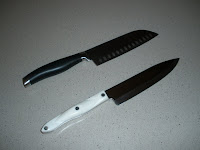Chicken Burgers on the Grill
(4 servings)
Ingredients:
1 lb. Boneless Skinless Chicken Breasts, cut into small pieces
1 tbsp. Fresh Ginger, minced
4 Green Onions, white parts only thinly sliced
1/2 cup Panko Bread Crumbs
1 large Egg, beaten
1/3 to 1/2 cup Fresh Cilantro, chopped
1 tsp. Lime Zest, grated and chopped
1/2 tsp. Salt
1/2 tsp. Black Pepper
Directions:
Place chicken, ginger and green onion in a food processor with the blade attachment. Set the processor on high and using the pulse button, pulse until the mixture is a medium grind. It won't hurt if it is a little over or under ground. Place the mixture in a mixing bowl and add all the remaining ingredients and mix by hand. Divide the mixture into 4 portions and form into patties with your hands. Place on the patties on a plate and refrigerate for at least 30 minutes. When ready to cook, place on an outdoor grill and cook for 6 to 8 minutes per side. Serve with your favorite condiments on buns of your choice.
Note: I have made this recipe into 8 smaller patties and served them as sliders
with hamburger slides for everyone to have some variety with smaller
portions.
Note: You could use ground chicken or turkey if you don't have a food
processor. I just like the courser mix and I know what I'm getting when
I grind it myself.
Ideas for Future Efforts
___________________________________________________
___________________________________________________
___________________________________________________
___________________________________________________
___________________________________________________


